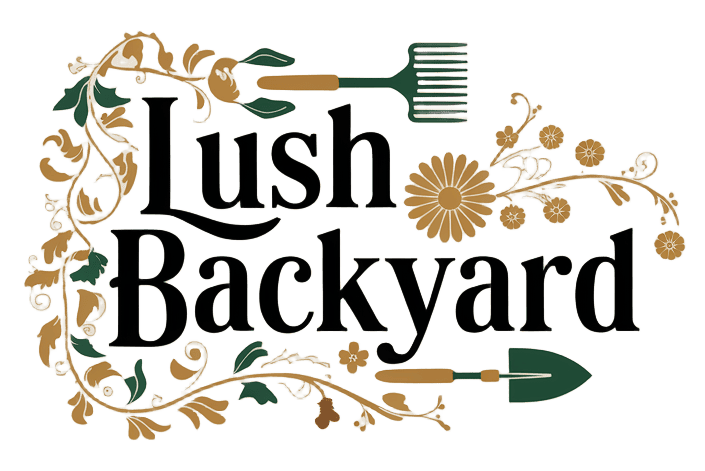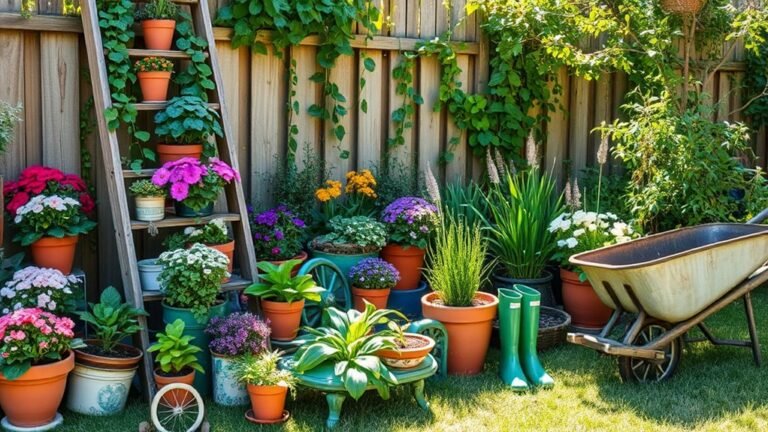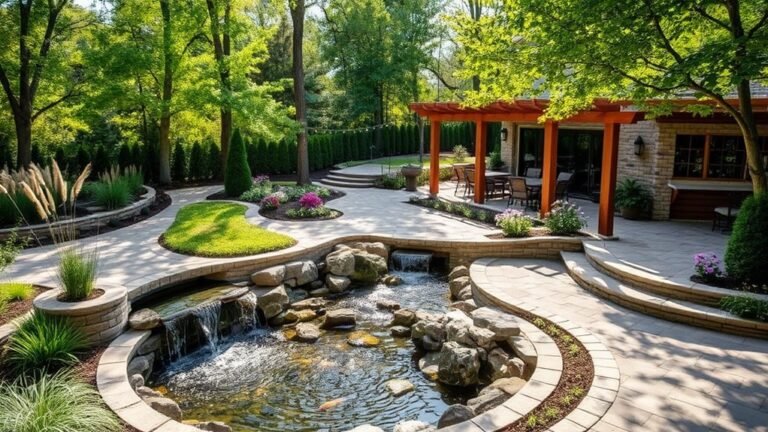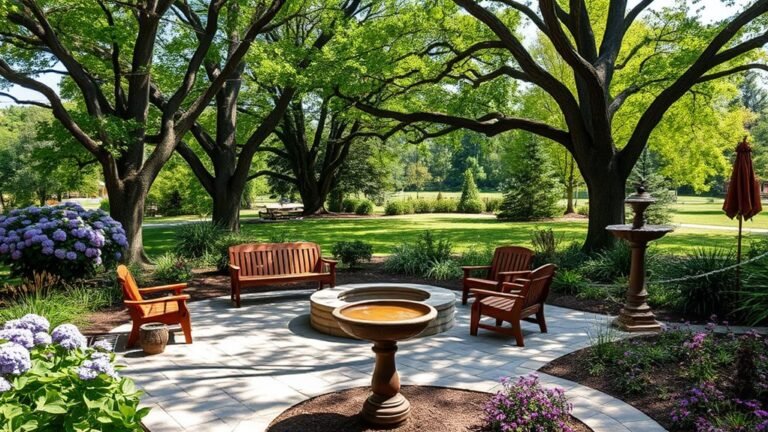15 Charming Backyard Butterfly Garden Ideas
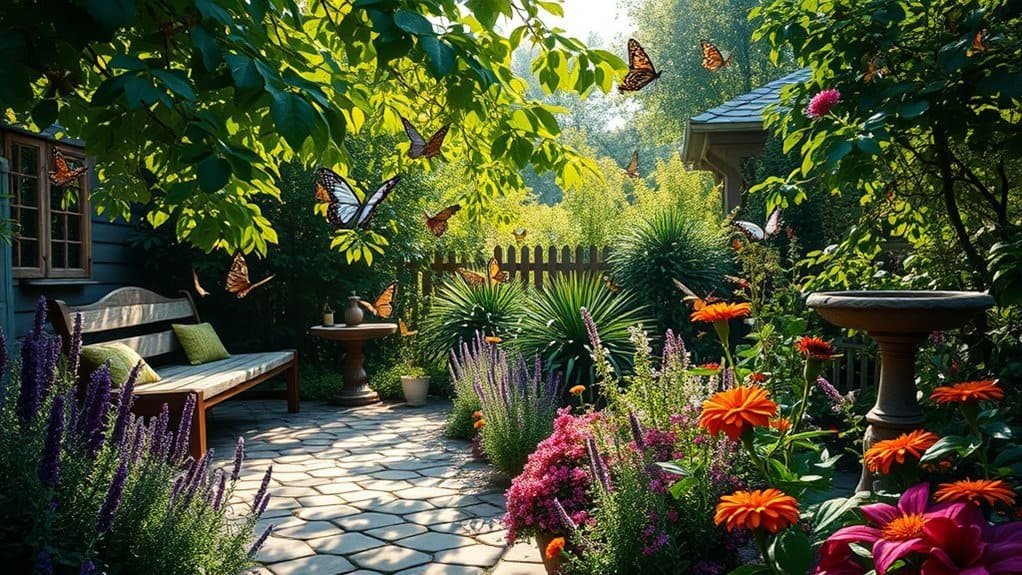
Creating a butterfly garden in your backyard is akin to designing a vibrant living artwork. By carefully selecting native flowers and structures, you can attract these beautiful pollinators to your space.
To ensure your garden thrives with life and color, consider specific elements that enhance its appeal. Thoughtful choices in plants and inviting spaces are crucial for fostering a flourishing habitat.
Native Wildflower Planting
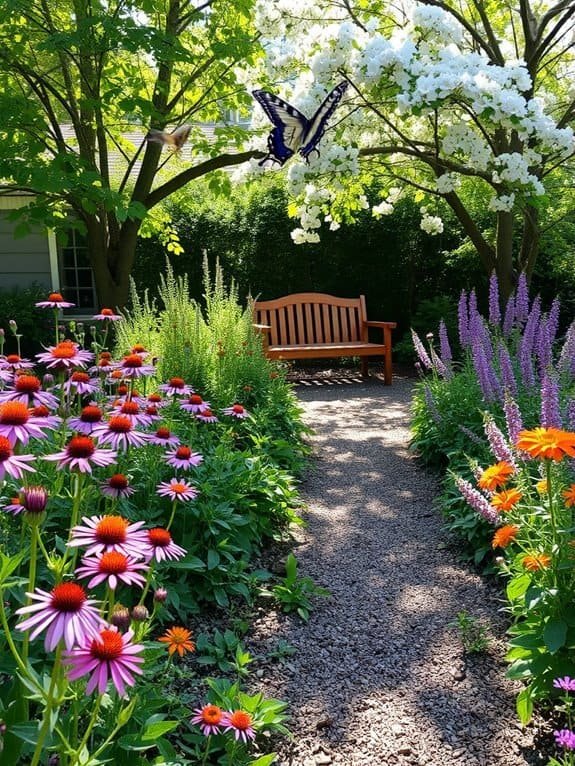
Creating a vibrant butterfly garden begins with planting native wildflowers that attract butterflies and support local ecosystems.
Choose a variety of wildflowers such as coneflowers, black-eyed Susans, and milkweed; these not only catch the eye but serve as food sources for butterflies. Plant in clusters to make it easier for butterflies to locate their meals and to add color to your garden.
Select sunny spots for planting, as butterflies thrive in sunlight, and include water sources like shallow dishes filled with pebbles for hydration.
As your flowers bloom, expect to see beautiful butterflies gracing your yard, creating a living painting.
Grab your gardening gloves and cultivate a wildflower haven that will bring joy and beauty to your space!
Butterfly-Friendly Container Gardens
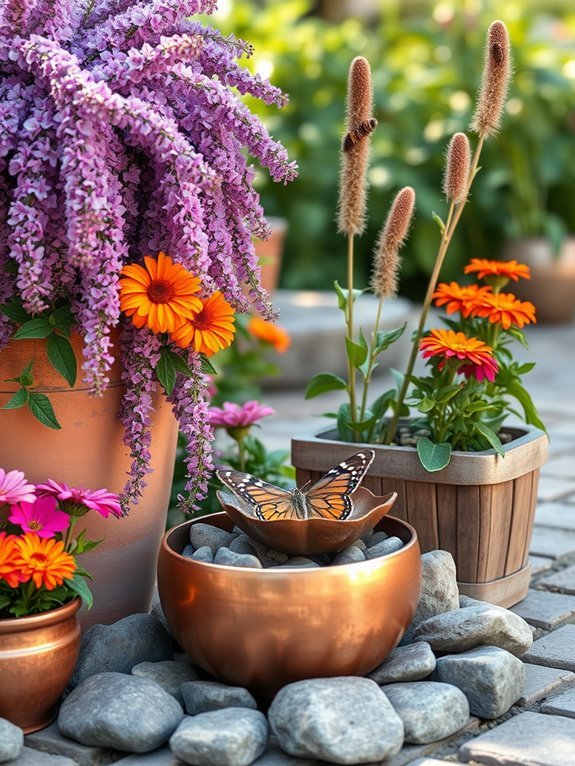
To attract butterflies to your outdoor space, create butterfly-friendly container gardens. These havens can be placed on patios or balconies, perfect for any size area. Imagine sipping your morning coffee while colorful butterflies flutter nearby!
Choose containers with good drainage and fill them with rich, organic soil. Select a variety of butterfly-attractive plants, including caterpillar host plants. Add rocks or shallow dishes with water for butterflies to land and hydrate.
Mixing heights and textures enhances aesthetics and provides a cozy environment for butterflies. You can change your arrangements seasonally to keep the garden fresh.
Soon, your container garden will be alive with butterflies, giving you a delightful outdoor experience. Grab those pots and start planting—your butterflies are waiting!
Colorful Nectar Plants
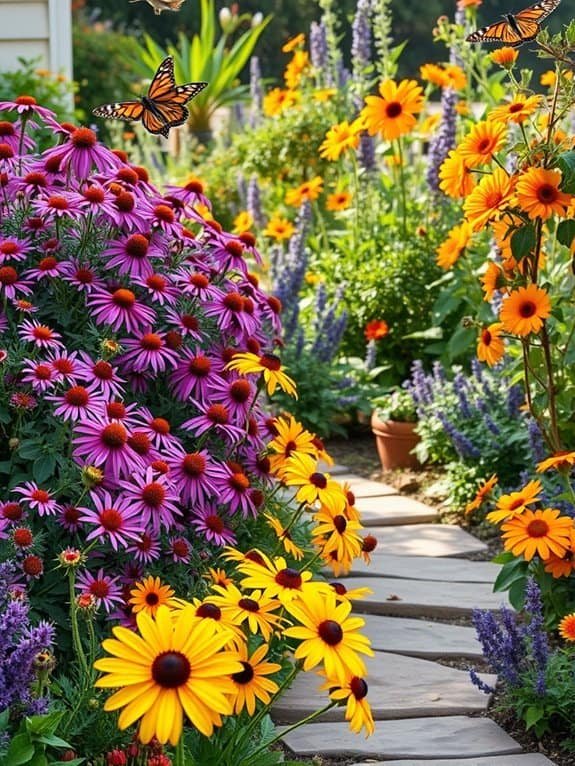
Colorful nectar plants are vital for attracting butterflies to your garden, adding vibrancy and providing the sweet sustenance they crave. To ensure your garden remains a butterfly haven throughout the season, select a variety of plants that bloom at different times.
Here's a quick list of excellent nectar plants to consider:
| Plant Name | Color | Blooming Season |
|---|---|---|
| Coneflower | Purple | Summer |
| Butterfly Bush | Pink/Purple | Summer |
| Milkweed | Orange/Yellow | Late Summer |
Water Sources for Butterflies
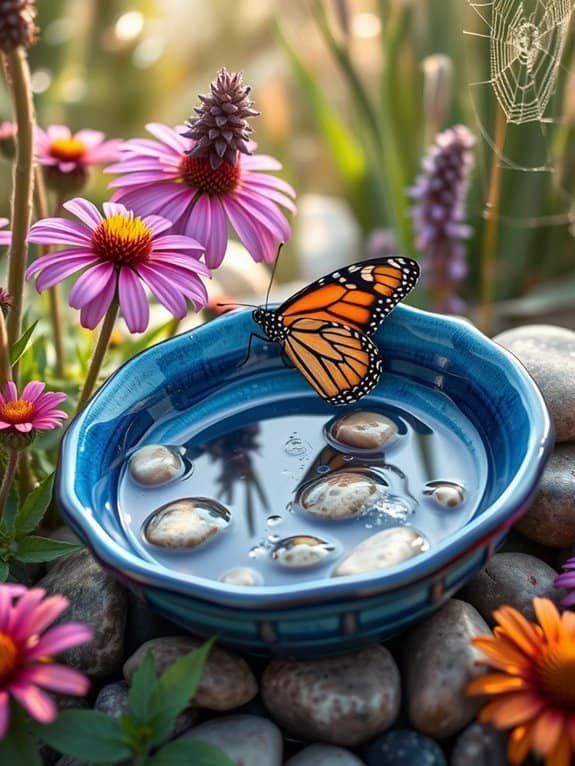
While vibrant nectar plants attract butterflies, water sources are equally crucial for their well-being. Butterflies require hydration, so consider creating simple water features in your garden. A shallow dish filled with fresh water is a great start—adding pebbles or marbles allows butterflies to land without getting wet.
Another option is to place a sponge in a bowl of water. The sponge retains moisture while providing a safe sipping spot for butterflies. Just remember to change the water regularly to keep it fresh.
For a more adventurous idea, create a small puddling area by filling a shallow tray with sand and adding a bit of water. Butterflies are drawn to these muddy spots for the minerals and nutrients they offer.
Butterfly Feeding Stations
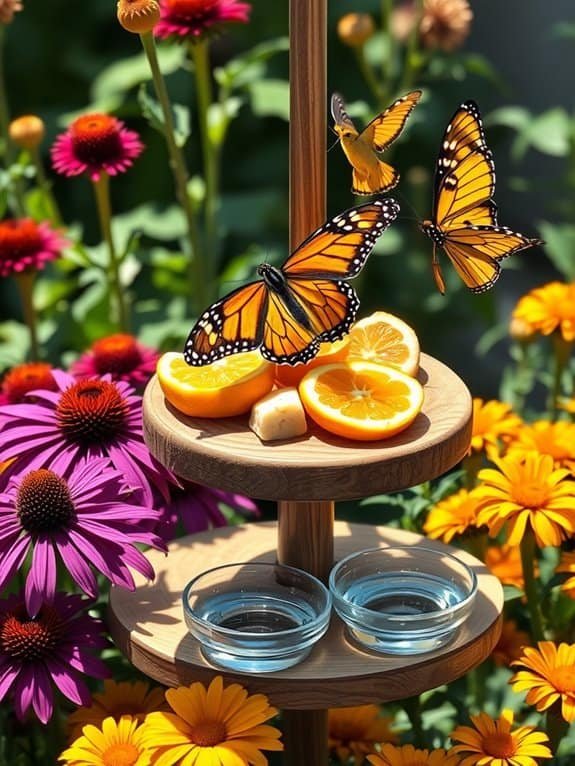
Creating butterfly feeding stations enhances your garden's appeal by providing essential nourishment for these beautiful creatures. Imagine butterflies fluttering around, sipping nectar, and adding vibrant colors to your yard. Setting up these stations is easy with a few simple ingredients.
Here's a quick guide to creating the perfect butterfly buffet:
| Feeding Station | Ingredients | Tips |
|---|---|---|
| Nectar Dish | Sugar water (1:4 mix) | Change every few days |
| Fruit Station | Overripe bananas | Cut into small pieces |
| Sponge Nectar | Wet sponge with sugar | Keep it moist, not soggy |
| Honey Jar | Diluted honey | Secure to avoid spills |
| Puddling Station | Shallow dish of water | Add a pinch of salt |
Host Plants for Caterpillars
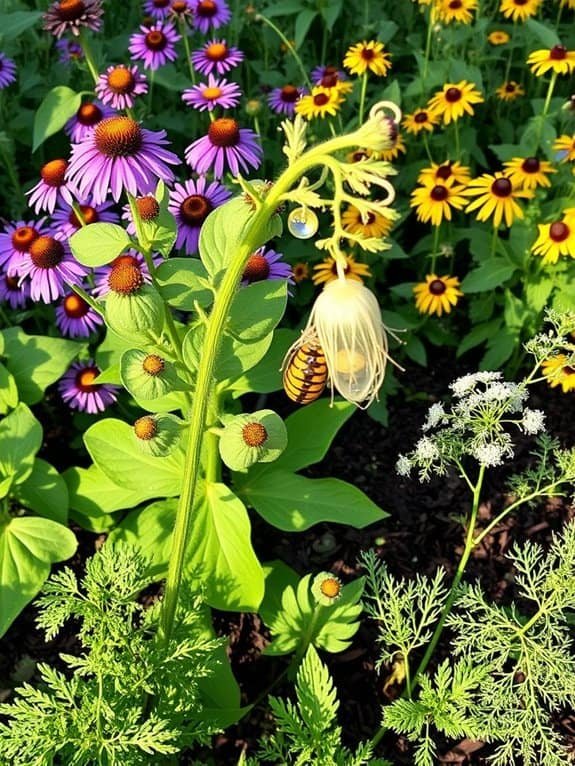
To attract butterflies to your garden, you need to provide host plants for their caterpillars, which are crucial for their growth.
Here are four excellent host plants to consider:
- Milkweed – This is essential for monarch butterflies who are drawn to its lovely blooms.
- Parsley – This herb not only enhances your kitchen but is also a favorite of swallowtail caterpillars.
- Fennel – Another appealing herb, fennel attracts swallowtail caterpillars and adds flavor to your dishes.
- Aster – These delightful flowers aren't only beautiful but also host various butterfly species, adding color to your garden.
Vertical Garden Designs
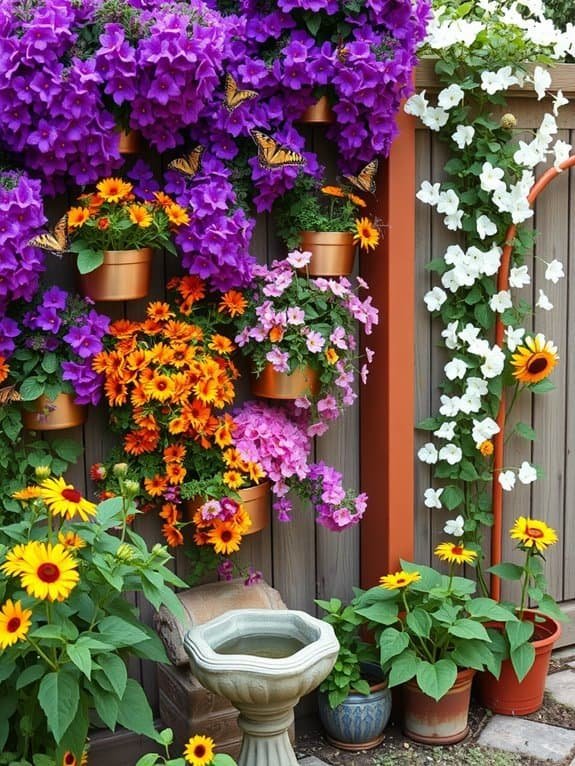
Maximize your backyard space with stunning vertical garden designs. These arrangements allow you to grow a variety of plants while taking up minimal ground space, making them perfect for any garden size. You can use wall planters, hanging pots, or repurposed pallets to create a beautiful green wall.
Imagine entering your backyard to a lush tapestry of colorful flowers and foliage. Plant butterfly favorites like milkweed and zinnias to attract these lovely insects.
Vertical gardens are easy to maintain with regular watering and sunlight!
Feel free to mix and match plants—use trailing vines for a cascading effect or bold blooms for a striking pop of color. You can even add herbs or vegetables, like fresh basil, right from your wall!
Get creative and transform your backyard into a vibrant butterfly haven!
Garden Pathways With Flowers
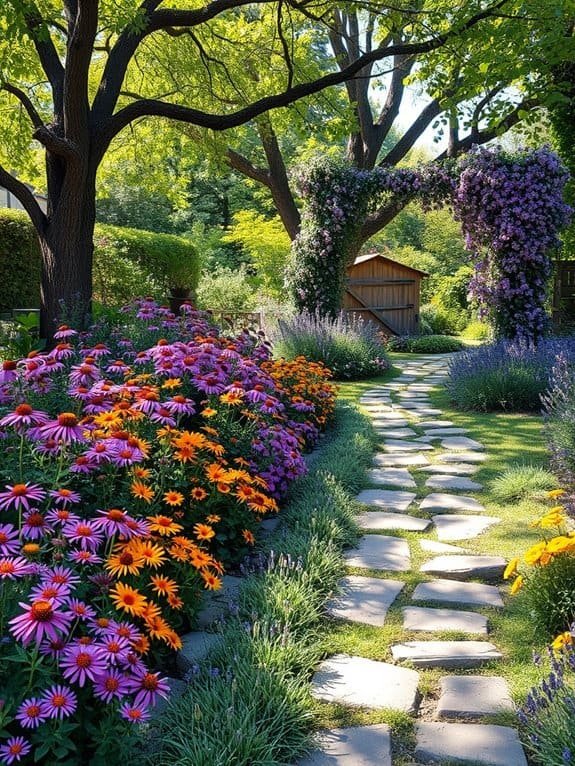
Create a stunning vertical garden that guides guests along charming pathways filled with vibrant flowers. Each step can feel like a delightful adventure in nature. Incorporating various plant heights and textures will enhance the garden’s allure, creating a dynamic visual experience. Additionally, consider incorporating small backyard flower garden ideas that can complement the vertical elements, making the space feel even more inviting. The colorful blooms can attract pollinators, bringing life and movement to your enchanting retreat. Incorporate various plants that bloom in different seasons to ensure a continuous display of color and life. As you explore, these elements can serve as inspiration for small backyard garden designs, allowing you to create a personal oasis that reflects your style. With thoughtful placement and diverse textures, your vertical garden will not only enhance the beauty of your space but also provide a serene retreat for relaxation and reflection.
Here are some ideas to enhance your garden pathways:
- Flower Borders: Frame your pathways with colorful blooms that blossom at different times for a year-round display.
- Pet-Friendly Plants: Choose non-toxic flowers like marigolds and snapdragons for a safe environment for furry friends.
- Seasonal Blooms: Use seasonal flowers such as tulips in spring and sunflowers in summer for variety.
- Whimsical Signage: Incorporate quirky signs to guide visitors and add a touch of humor to the experience.
Consider adding decorative lighting along your garden pathways to enhance ambiance and ensure safety for evening strolls. These ideas will transform your garden pathways into visual delights for all who visit. Happy gardening!
Natural Sun and Shade Areas
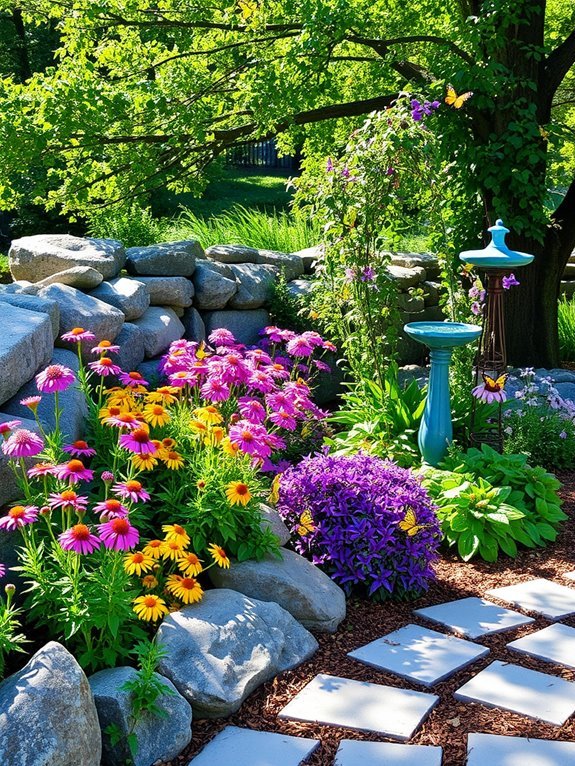
Creating a butterfly garden requires a careful balance of sun and shade areas, as both significantly affect butterfly activity. Butterflies thrive in sunny spots for warming their wings, so incorporate sunlit areas with nectar-rich flowers like sunflowers, zinnias, and coneflowers to attract them.
However, shade is equally important. It offers a cool retreat, especially on hot days, and provides an ideal environment for caterpillars. Consider planting ferns or hostas for both aesthetic appeal and as cozy shelters for these larvae.
When designing your garden, position sun and shade areas close together to allow butterflies to easily transition between them. This combination also creates a visually appealing contrast.
Get started on your butterfly paradise by blending sunny spaces with shaded havens, and enjoy the delightful presence of butterflies in your backyard!
Decorative Butterfly Houses

As you design your butterfly garden, don't forget the charm of decorative butterfly houses. These delightful structures offer shelter and add a whimsical touch to your outdoor space.
Here's how to make the most of them:
- Choose Unique Designs: Pick a design, such as tiny cottages or whimsical castles, that reflects your personality—after all, butterflies appreciate style too!
- Consider Location: Place your butterfly house in a sunny, sheltered area to attract more guests who love to bask in warmth.
- Use Natural Materials: Select wood or bamboo for an eco-friendly look that integrates well with your garden.
- Add Fun Decor: Bright paint or cute decorations can enhance your butterfly house's appeal, drawing attention from both butterflies and your neighbors!
With these tips, you'll create a cozy haven for butterflies while boosting your garden's charm.
Get ready to welcome your new winged friends!
Seasonal Blooms for Variety

To keep your butterfly garden vibrant year-round, selecting seasonal blooms is crucial. Envision stepping into your garden filled with colorful flowers and butterflies! Choosing flowers that bloom in different seasons provides sustenance for these lovely creatures while keeping your garden fresh.
Here's a quick guide for choosing the right seasonal blooms:
| Season | Flower | Color |
|---|---|---|
| Spring | Butterfly Bush | Purple, Blue |
| Summer | Coneflower | Pink, Yellow |
| Fall | Aster | White, Lavender |
In spring, the Butterfly Bush lures in butterflies with its vibrant purple hues. As summer arrives, the Coneflower adds lively pink and yellow. Finally, in fall, Aster's white and lavender blooms ensure your garden remains inviting.
Fragrant Plants to Attract

Incorporating fragrant plants into your butterfly garden enhances its charm, attracting butterflies and other pollinators with their delightful scents.
Imagine stepping into your backyard and being greeted by a symphony of sweet aromas, like a natural perfume shop for butterflies!
Consider these fragrant plants:
- Lavender – This classic not only smells heavenly but also attracts various butterflies and is great for sachets.
- Buddleia (Butterfly Bush) – Renowned for attracting butterflies, it also fills the air with a sweet scent.
- Mint – With a fresh and invigorating fragrance, mint is a must-have, though it can spread quickly.
- Jasmine – This enchanting plant emits a sweet scent in the evening, perfect for dusk in your garden.
Edible Butterfly Gardens
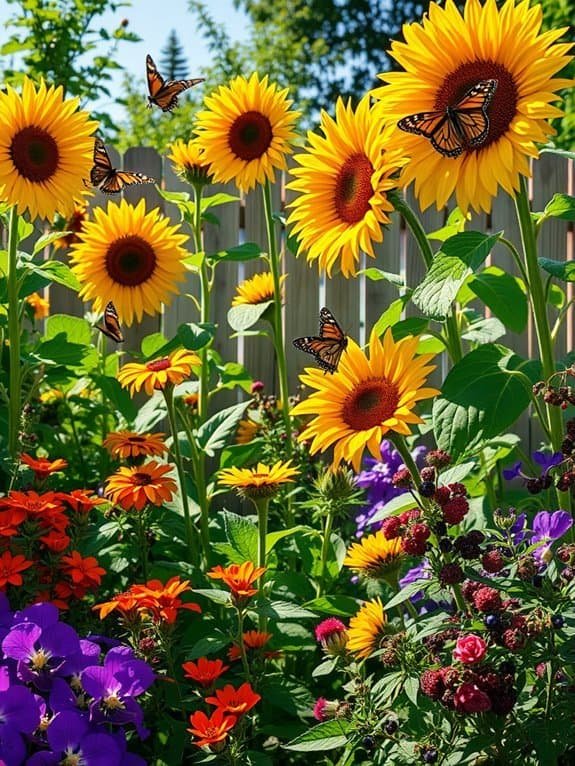
Creating a butterfly garden can yield delicious rewards alongside its beauty. Imagine enjoying a refreshing beverage made with your homegrown mint as butterflies flutter around.
Start by planting herbs like basil, dill, and parsley, which attract butterflies and can be used in cooking!
Flowers like nasturtiums and borage are excellent choices too. Nasturtiums are spicy and edible, perfect for salads, while borage adds a refreshing cucumber flavor to drinks and attracts butterflies like monarchs and swallowtails.
Don't overlook fruit-bearing plants! Blueberries and strawberries provide tasty treats for you while attracting pollinators and butterflies.
Picture a butterfly fluttering by as you pick a juicy berry straight from the plant—what a delightful garden snack!
Pollinator Partnerships
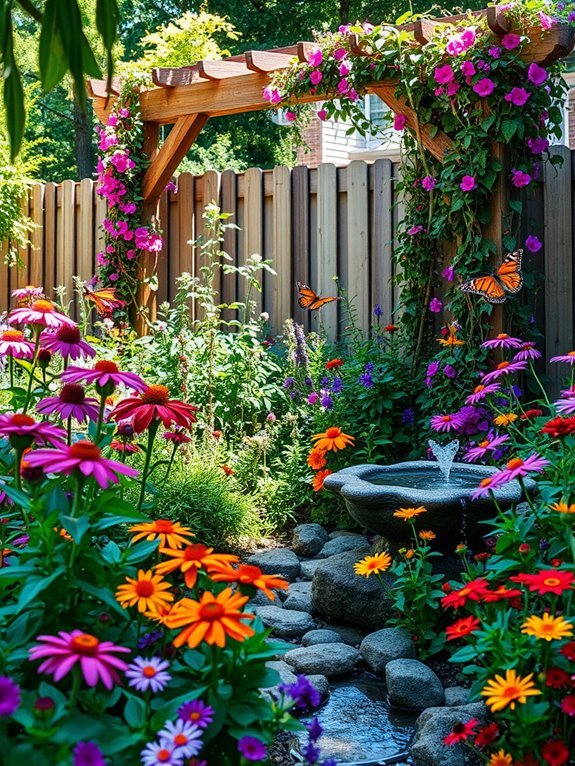
While butterflies steal the show, other pollinators like bees, hummingbirds, and bats are crucial for a thriving garden ecosystem.
By welcoming these creatures, you're fostering beauty and nurturing your environment. Here are four simple ways to enhance your pollinator partnerships:
- Plant Native Flowers: Opt for native flowers that provide the best nourishment for local pollinators.
- Create Shelter: Include small brush piles or allow some areas to remain wild for cozy resting spots.
- Avoid Pesticides: Maintain a chemical-free garden, benefiting all pollinators alongside butterflies.
- Provide Water Sources: Place shallow dishes with pebbles for bees and butterflies to drink from.
Implementing these tips will transform your garden into a buzzing haven for all your pollinator friends!
Garden Art and Decor
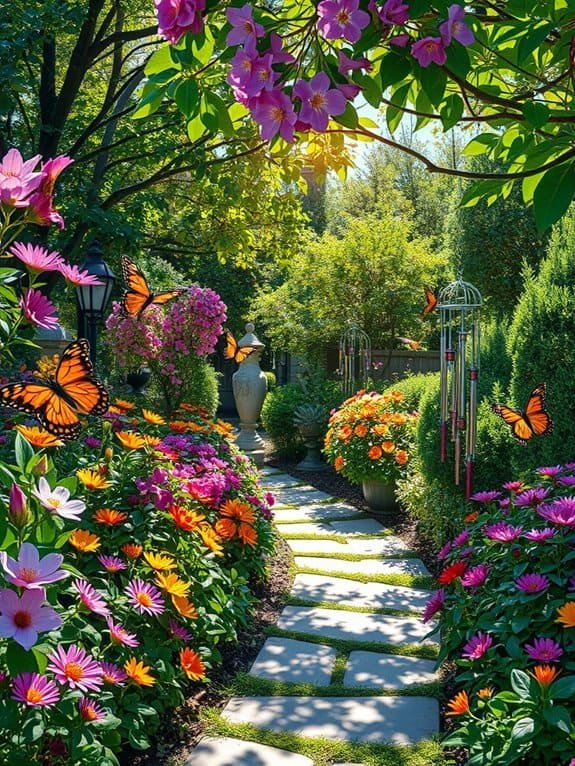
Transforming your backyard into a butterfly paradise goes beyond just plants; incorporating garden art and decor enhances your space's beauty and ambiance.
Visualize vibrant wind chimes swaying in the breeze, their soothing sounds attracting butterflies and guests alike. You might hang colorful butterfly-shaped ornaments from tree branches to create a whimsical atmosphere.
Consider adding a charming birdbath that not only quenches butterflies' thirst but also serves as a delightful garden focal point. Quirky garden gnomes or fairy houses could spark joy and conversation.
Don't forget playful signage to guide guests through the garden, indicating which flowers are butterfly favorites.
Lighting can set the mood too; solar-powered lanterns or fairy lights along pathways create a magical ambiance as the sun sets.
Let your personality shine! Embrace creativity and inject some humor to make your butterfly garden truly enchanting.
Happy decorating!
Frequently Asked Questions
How Do I Attract Specific Butterfly Species to My Garden?
To attract specific butterfly species to your garden, start by planting their favorite nectar and host plants.
Monarchs love milkweed, while Swallowtails can't resist parsley.
Make sure to provide sunny spots for them to bask and some sheltered areas for resting. A shallow water source is also a hit!
So, roll up your sleeves, get planting, and soon you'll have butterflies fluttering around like they own the place.
Happy gardening!
What Is the Best Time of Year to Start a Butterfly Garden?
The best time to start a butterfly garden is in the spring! That's when flowers bloom, and butterflies are on the lookout for food.
You'll want to prepare your garden in early spring, planting nectar-rich flowers and host plants for caterpillars.
Just imagine watching those colorful butterflies fluttering around! Plus, it's a great excuse to dig in the dirt and get your hands a little messy. Who wouldn't love that?
How Can I Create a Garden That Supports Other Pollinators?
Creating a garden that supports pollinators is easier than you might think!
Start by planting a variety of flowers that bloom at different times—think of it as a buffet for bees and butterflies.
Don't forget to include herbs like basil and mint; they love those!
You can even add a small water source, like a shallow dish with pebbles.
Trust me, your garden will buzz with life and color, making it a delightful spot to enjoy!
Are There Any Plants Toxic to Butterflies I Should Avoid?
Avoiding toxic plants is key to keeping butterflies buzzing happily. Stay clear of common culprits like foxglove and oleander—they're pretty but perilous!
Instead, think about planting safe selections like milkweed and asters. They attract butterflies without the danger. A garden filled with fabulous flowers is what you want!
What Maintenance Is Required for a Butterfly Garden Throughout the Year?
To keep your butterfly garden thriving, regular maintenance is key!
You'll want to check for weeds, dead plants, and pests, giving everything a good tidy-up.
Watering is important, especially in dry spells, so don't forget that!
In spring, prune back any overgrown plants.
And in fall, you can leave some seed heads for the birds.
It's like a little nature party, and you're the host—just without the awkward small talk!
Conclusion
Creating a butterfly garden invites nature into your backyard. A single butterfly can visit up to 1,000 flowers in a day.
By planting a variety of native blooms and adding water sources, you'll attract these beautiful pollinators. Incorporate fun garden art to enhance your space and watch it transform into a fluttering paradise!
